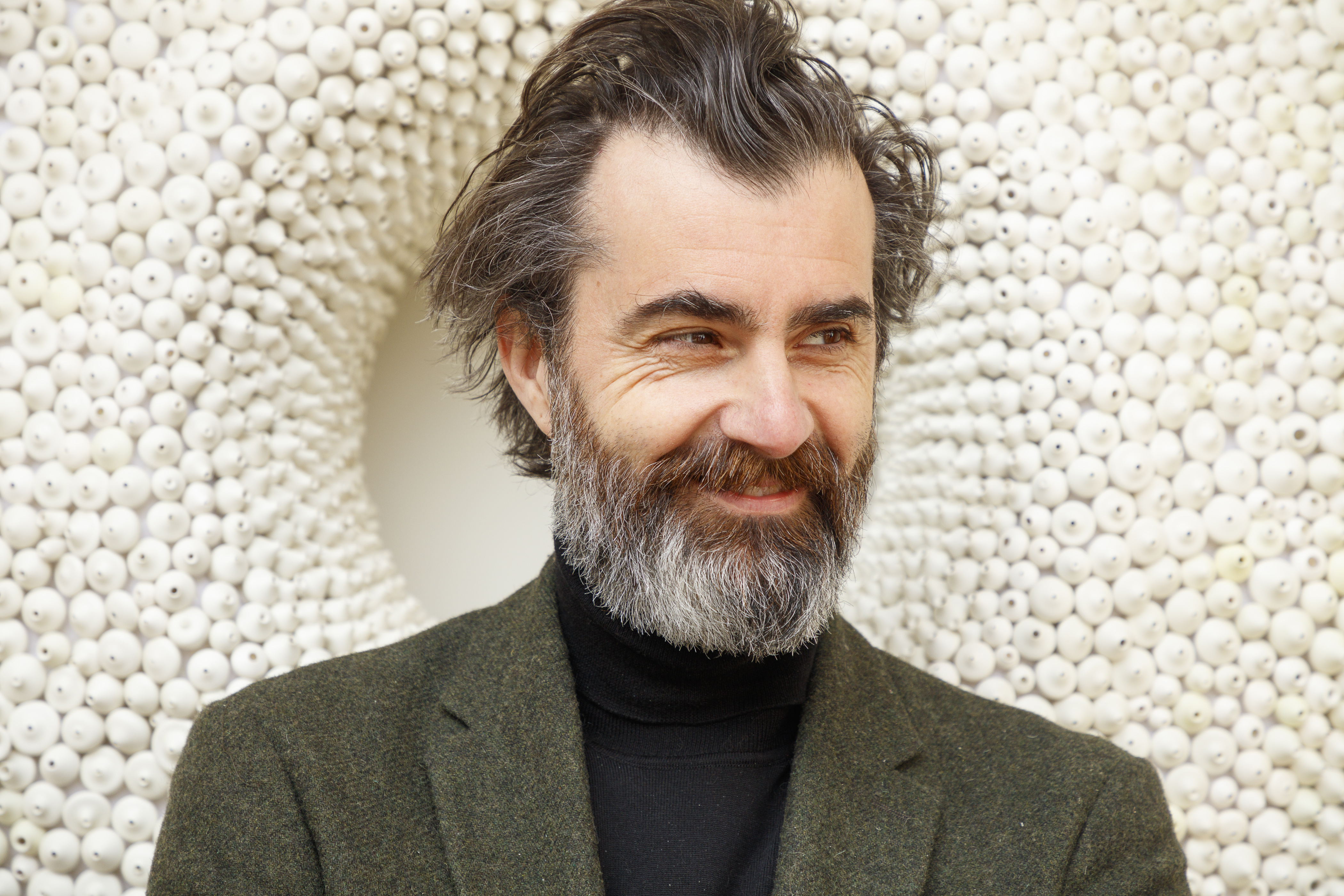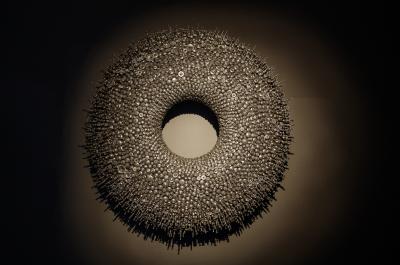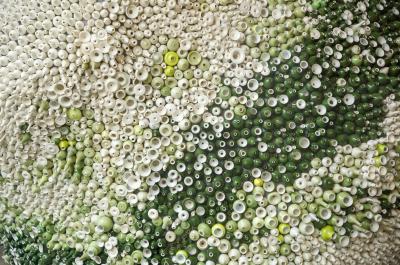C. Grégoire Scalabre
"L’ultime métamorphose de Thétis", "Cygnus" and "L’onde"

Grégoire Scalabre is a consummate ceramist. His sculptures are genuine discoveries, spectacular objects of concentration and imagination far exceeding the discipline’s traditional boundaries and taking pride of place at contemporary art events in and outside France. The result of long, methodical work, each piece bears witness to the techniques he employs to create new textures and forms.
The studio sees the creative process unfold. The work takes shape in its centre as a multitude of pieces that the artist has crafted one by one are assembled. Notebooks bursting at the seams are strewn across a long workbench, some of their pages facing the wall. There are hand-drawn plans, views, sketches… It seems that each form has to be depicted from every angle, as if the artist’s hands had to start by mastering the object’s image before getting to grips with the material itself.
Grégoire Scalabre creates as he breathes, freely. A past master in the various ceramic techniques, he can envisage anything, the incredible most of all, opening up his register of expression to the most varied forms and textures imaginable in his search for a unique, evolving vocabulary. He wants beholders to speculate, uncertain of what they are looking at. Is it stone? Is it porcelain? Is it rubber? Playing with surface effects, the ceramist blurs the boundaries, deceives the senses in order to provide the material with unexpected surface, fullness and depth. His pieces are created in a register that encompasses the minutiae of their components and the monumentality of their assembly alike.
A perfectionist, the artist confronts the work he sets himself alone. As if hypnotised by the endless repetition of the same actions, he lets emotions rise within him, consciously becoming the present moment. The visual objective appears in all its clarity, though not until the form has taken final shape. Grégoire Scalabre does not seek to bewilder but rather to put himself at the service of a medium to which he owes everything and which loves him in return.
L’ultime métamorphose de Thétis
L’Ultime Métamorphose de Thétis, which was first exhibited in Venice for Homo Faber 2022, is composed of thousands of miniature amphorae (between 2 and 3 cm), their colours ranging from white to green by way of beige. 2 metres high, 1.6 metres wide and weighing 450 kilos, the piece is composed of 70,000 of these tiny objects, turned and enamelled one by one by the artist’s hand. The work is a tribute to Thetis, the best known of the Nereids, wife to the mortal King Peleus and mother wounded to the heart by the tragic death of her son Achilles. Ceramics’ water and fire to evoke a deity marked by sea and war alike. Creation as the Greek goddess’ umpteenth metamorphosis.
Cygnus
Scalabre’s remarkable porcelain wall medallion, Cygnus, is composed by more than 9,000 miniature porcelain vessels, each patiently thrown on the wheel by Scalabre. Cygnus was inspired by the historic shipwrecks of the East India Company. Shipwrecks were a frequent occurrence throughout the Georgian era. Among the lost cargo was an estimated number of nearly 200 pieces of fine porcelain from Asia. Scalabre’s individual vessels converge, and are encrusted onto a large wreath-like form akin to barnacles on a ship. The wreath shape, traditionally suggesting eternity, pays homage to the mythical freight of porcelain, forever removed from all humankind, reborn deep inside the sea.
L’Onde (the wave)
BIOGRAPHICAL NOTES

Grégoire Scalabre is a French artist, ceramist and sculptor, internationally recognised for the virtuosity of his work. His artistic universe draws much of its inspiration from industrial architecture, the architectural heritage of French monuments, and the realm of statuary. An altogether atypical figure on the contemporary landscape, Grégoire Scalabre is tireless in pushing back the limits of ceramic creation. He defies matter in order to provide a constantly renewed repertoire of forms: from the register of dissemination and accumulation to that of dynamism and monumentality, by way of architecture and metallurgy.
His interest in ceramics goes back to his childhood. A little boy with a fertile imagination, he liked to observe, draw and piece together things that helped him tell stories. There was no question of waiting for adventure to come to him from the outside, he preferred to take the initiative himself. And still today, he immerses himself in a project just as yesterday he built treehouses as settings for his made-up stories. A rather unruly child, however, young Grégoire was sent to a boarding school in Normandy, where he discovered the plasticity of clay and ways of transforming it. Fascinated by the power of water and fire, he knew at once what he would do with his life. A revelation that was followed by an apprenticeship at the Atelier du Sage in the town of Dieulefit in Drôme, complemented at theoretical level at the Lycée de la Céramique in Longchamp.
With a passion for architecture and design, his artistic approach was soon confirmed by a renewal of the basics of his craft at Agir Céramique, and further enriched by a course on the chemistry of enamelling. So many initiatives that enabled him to develop remarkable technical mastery and aesthetic sensibility. But his sensorial experience could not be allowed to restrict his practice, so Grégoire Scalabre decided to further it by agreeing to become a ceramics teacher at Bois d’Arcy Prison. Since then, he has never stopped walking on two legs: creation and teaching. In 2000, the French Institute of Ceramics (IFC) put him in charge of a training workshop focusing on turning. He was 26 years old. He founded his own workshop two years later, and went on to set up the École de Céramique in Paris in 2005, in collaboration with Christophe Bonnard.
Although Grégoire Scalabre collaborated with design editors early on in his career, becoming one of the Maison &Objets fair’s “à-la-carte talents,” he turned his back on utilitarian creation in the late 2000s to put his knowhow at the service of an exclusively artistic approach. His residency at the Sèvres Manufactory in 2009 and 2010 resulted in Astrée, a monumental work that went on to be exhibited at Paris’ Museum of Decorative Arts as part of the Circuits Céramiques exhibition (winter 2010-2011), and Haussmann, a series of sculptures in the form of plaster models, making up an architectured landscape true to the principle of stucco moulding so dear to the Haussmannian style. His research over the course of the following year focused on a variety of questions, including “How do you refine while destructuring?” “How do you show what is not?” “How do you direct the eye not simply to the structure’s outside but also to its inside?” Several of these creative chapters were exhibited at the NeC Gallery in Paris and the Modern Shapes Gallery in Antwerp.
In 2015, Grégoire Scalabre joined forces with a ceramist friend to create the Atelier Céramique in Le Kremlin-Bicêtre (where construction work was completed in 2020). The idea was to create a centre for exchange and transmission of knowhow based on a contemporary vision of ceramics. Courses and traineeships in turning and modelling for amateurs and professionals alike are dispensed there, along with training programmes preparatory to the CAP (Certificate of Professional Aptitude) in ceramic turning. In 2017, he authored an educational work entitled Céramique: répertoire de formes, published by Éditions Eyrolle. Broadening his register of expression is an ongoing concern of his, driven by a tireless curiosity for new techniques. In 2018, the pieces that left his workshop were created through the process of marbling ceramics. In 2022, still certain that his teaching (especially to professionals) nourishes his artistic practice and vice versa, he founded a new workshop for transmission of knowhow and ceramic techniques, in collaboration with Virginie Mercier.


